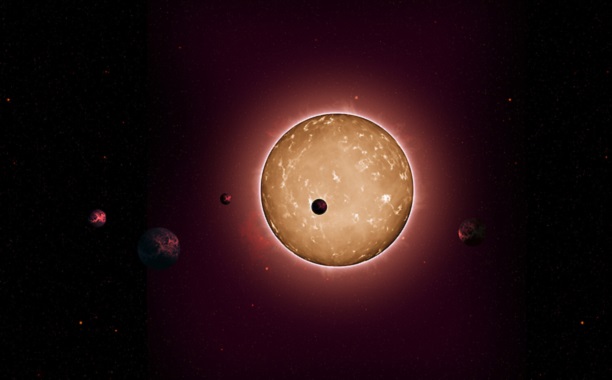NASA’s Kepler Space Telescope has discovered a new solar system roughly 117 light-years from Earth that plays host to five Earth-sized planets orbiting a star, Kepler-444, that’s more than twice as old as the Sun.
The five rocky planets circling Kepler-444, which is 11.2 billion years old, are too close to the star to fall within the “Goldilocks zone” around the star which would be warm enough, but not too warm, to support the existence of liquid water and the possibility of life.
Astronomers have indicated that the solar system may assist scientists in pinpointing when Earth-like planets first began to form and it might also have what a Huffington Post report calls “important implication for the possibility of alien life.” The report quotes a research fellow at the University of Birmingham who helped discover the new solar system, Dr. Tiago Campante, as having said that there are “far-reaching implications” for this recent discovery that “could provide scope for the existence of ancient life in the Galaxy.”
There are far-reaching implications for this discovery […] We now know that Earth-sized planets have formed throughout most of the Universe’s 13.8-billion-year history, which could provide scope for the existence of ancient life in the Galaxy.
Campante said in an e-mail to The Huffington Post:
Other similarly old planets could indeed harbor life […] Think about a technologically advanced civilization that has a few billion years head start relative to us
The ancient star system was detected by examining data collected b Kepler over the course of four years and applying a technique known as asteroseismology to determine the star’s mass, diameter, and age. The five planets were detected using transit photometry, a process which involves observing slight dims in a star when planets pass across its face.
The five planets circling Kepler 444 are known as Vulcan planets due to their close proximity to their star. Vulcan planets are nearly 100 times closer to their stars than the Earth is to the Sun, the Smithsonian Mag reported. The name is derived from the Roman god Vulcan, a god associated with fire, metal-working, forges, and volcanoes.
In related news reported on Immortal News, NASA e-mailed a 3D wrench to space for the first time.
What do you think of this recently discovered ancient solar system?
























